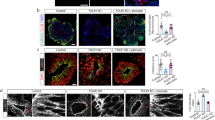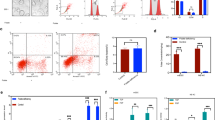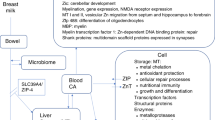Abstract
Clinical trials demonstrate that up to 70% of neural tube defects (NTDs) can be prevented by folk acid supplementation in early pregnancy, whereas the remaining NTDs are resistant to folate. Here, we show that a second vitamin, myo-inositol, is capable of significantly reducing the incidence of spinal NTDs in curly tail mice, a genetic model of folate-resistant NTDs. Inositol increases flux through the inositol/lipid cycle, stimulating protein kinase C activity and upregulating expression of retinoic acid receptor β, specifically in the caudal portion of the embryonic hindgut. This reduces the delay in closure of the posterior neuropore, the embryonic defect that is known to lead directly to spina bifida in curly tail embryos. Our findings reveal a molecular pathway of NTD prevention and suggest the possible efficacy of combined treatment with folate and inositol in overcoming the majority of human NTDs.
This is a preview of subscription content, access via your institution
Access options
Subscribe to this journal
Receive 12 print issues and online access
$209.00 per year
only $17.42 per issue
Buy this article
- Purchase on Springer Link
- Instant access to full article PDF
Prices may be subject to local taxes which are calculated during checkout
Similar content being viewed by others
References
Smithells, R.W. et al. Apparent prevention of neural tube defects by periconceptional vitamin supplementation. Arch. Dis. Child. 56, 911–918 (1981).
Wald, N., Sneddon, J., Densem, J., Frost, C., stone, R. & MRC Vitamin Study Research Group. Prevention of neural tube defects: Results of the Medical Research Council Vitamin Study. Lancet 338, 131–137 (1991).
Czeizel, A.E. & Dudás, I. Prevention of the first occurrence of neural-tube defects by periconceptional vitamin supplementation. N. Engl. J. Med. 327, 1832–1835 (1992).
Seller, M.J. & Adinolfi, M. The curly tail mouse: An experimental model for human neural tube defects. Life Sci. 29, 1607–1615 (1981).
Letts, V.A., Schork, N.J., Copp, A.J., Bernfield, M. & Frankel, W.N. Mapping modifier genes for tail defects in curly tail mutant mice. Genomics 29, 719–724 (1995).
Seller, M.J., Vitamins, folic acid and the cause and prevention of neural tube defects. Ciba Found. Symp. 181, 161–173 (1994).
Van Straaten, H.W.M. et al. Dietary methionine does not reduce penetrance in curly tail mice but causes a phenotype-specific decrease in embryonic growth. J. Nutr. 125, 2733–2740 (1995).
Nishizuka, Y., Intracellular signaling by hydrolysis of phospholipids and activation of protein kinase C. Science 158, 607–613 (1992).
Cockroft, D.L. Changes with gestational age in the nutritional requirements of postimplantation rat embryos in culture. Teratology 38, 281–290 (1988).
Cockroft, D.L., Brook, F.A. & Copp, A.J. Inositol deficiency increases the susceptibility to neural tube defects of genetically predisposed (curly tail) mouse embryos in vitro. Teratology 45, 223–232 (1992).
Kucera, J. Rate and type of congenital anomalies among offspring of diabetic women. J. Reprod. Med. 7 61–70 (1971).
Reece, E.A., Homko, C.J., Wu, Y.-K. & Wiznitzer, A. Metabolic fuel mixtures and diabetic embryopathy. Clin. Perinatol. 20, 517–532 (1993).
Chen, W., Morriss-Kay, G.M. & Copp, A.J. Genesis and prevention of spinal neural tube defects in the curly tail mutant mouse: Involvement of retinoic acid and its nuclear receptors RAR-beta and RAR-gamma. Development 121, 681–691 (1995).
Cockroft, D.L. Dissection and culture of postimplantation embryos. in Postimplantation Mammalian Embryos: A Practical Approach. (eds. Copp, A. J. & Cockroft, D. L.) 15–40 (IRL Press, Oxford, UK, (1990).
Copp, A.J. Relationship between timing of posterior neuropore closure and development of spinal neural tube defects in mutant (curly tail) and normal mouse embryos in culture. J. Embryol. Exp. Morphol. 88, 39–54 (1985).
Copp, A.J., Crolla, J.A. & Brook, F.A. Prevention of spinal neural tube defects in the mouse embryo by growth retardation during neurulation. Development 104, 297–303 (1988).
Berridge, M.J., Downes, C.P. & Hanley, M.R. Neural and developmental actions of lithium: A unifying hypothesis. Cell 59, 411–419 (1989).
Huber, B.E. & Brown, N.A. 12-O-Tetradecanoylphorbol-13-acetate actions on macromolecular synthesis, ornithine decarboxylase, and cellular differentiation of the rat embryonic visceral yolk sac in culture. Cancer Res. 43, 5552–5559 (1983).
Chen, W., Morris-Kay, G.M. & Copp, A.J. Prevention of spinal neural tube defects in the curly tail mouse mutant by a specific effect of retinoic acid. Dev. Dyn. 199, 93–102 (1994).
Gruneberg, H. Genetical studies on the skeleton of the mouse. VIII. Curly tail. J. Genet. 52, 52–67 (1954).
Neumann, P.E. et al. Multifactorial inheritance of neural tube defects: Localization of the major gene and recognition of modifiers in ct mutant mice. Nature Genet. 6, 357–362 (1994).
Estibeiro, J.P., Brook, F.A. & Copp, A.J. Interaction between splotch (Sp)and curly tail (ct) mouse mutants in the embryonic development of neural tube defects. Development 119, 113–121 (1993).
Pinter, E. et al. Arachidonic acid prevents hyperglycemia-associated yolk sac damage and embryopathy. Am. J. Obstet. Gynecol. 155, 691–702 (1986).
Ruberte, E., Dolle, P., Chambon, P. & Morriss-Kay, G. Retinoic acid receptors and Cellular retinoid binding proteins.II. Their differential pattern of transcription during early morphogenesis in mouse embryos. Development 111, 45–60 (1991).
Copp, A.J., Brook, F.A. & Roberts, H.J. A Cell-type-specific abnormality of Cell proliferation in mutant (curly tail) mouse embryos developing spinal neural tube defects. Development 104, 285–295 (1988).
Pijnappel, W.W.M. et al. The retinoid ligand 4-oxo-retinoic acid is a highly active modulator of positional specification. Nature 366, 340–344 (1993).
Lyn, S. & Giguère, V. Localization of CRABP-I and CRABP-II mRNA in the early mouse embryo by whole-mount in situ hybridization: Implications for teratogenesis and neural development. Dev. Dyn. 199, 280–291 (1994).
Leonard, L., Horton, C., Maden, M. & Pizzey, J. A. Anteriorization of CRABP-I expression by retinoic acid in the developing mouse central nervous system and its relationship to teratogenesis.. Dev. Biol. 168, 514–528 (1995).
Kurie, J.M. et al. Retinoic acid stimulates the protein kinase C pathway before activation of its β-nuclear receptor during human teratocarcinoma differentiation. Biochim. Biophys. Acta 1179, 203–207 (1993).
Tahayato, A., Lefebvre, P., Formstecher, P. & Dautrevaux, M. A protein kinase C-dependent activity modulates retinoic acid-induced transcription. Mol. Endocrinol. 7, 1642–1653 (1993).
Essien, F.B. & Wannberg, S.L. Methionine but not folinic acid or vitamin B-12 alters the frequency of neural tube defects in Axd mutant mice. J. Nutr. 123, 27–34 (1993).
Zhao, Q., Behringer, R.R. & De Crombrugghe, B. Prenatal folic acid treatment suppresses acrania and meroanencephaly in mice mutant for the Cart1 homeobox gene. Nature Genet. 13, 275–283 (1996).
Levine, J. et al. Double-blind, controlled trial of inositol treatment of depression. Am. J. Psychiatry 152, 792–794 (1995).
Benjamin, J. et al. Double-blind, placebo-controlled, crossover trial of inositol treatment for panic disorder. Am. J. Psychiatry 152, 1084–1086 (1995).
Estibeiro, J.P., Copp, A.J., Cockroft, D.L., Brown, N.A. & Clarke, D.O. Extraction of macromolecules from embryonic material. in Postimplantation Mammalian Embryos: A Practical Approach. (eds. Copp, A. J. & Cockroft, D. L.) 173–204 (IRL Press, Oxford, UK, 1990).
Dollé, P., Ruberte, E., Leroy, P., Morriss-Kay, G. & Chambon, P. Retinoic acid receptors and cellular retinoid binding proteins. I. A systematic study of their differential pattern of transcription during mouse organogenesis. Development 110, 1133–1151 (1990).
Ruberte, E., Friederich, V., Morriss-Kay, G. & Chambon, P. Differential distribution patterns of CRABP I and CRABP II transcripts during mouse embryogenesis. Development 115, 973–987 (1992).
Wilkinson, D.G. In Situ Hybridisation: A Practical Approach (IRL Press, Oxford, UK, 1992).
Brook, F.A., Shum, A.S.W., Van Straaten, H.W.M. & Copp, A.J. Curvature of the caudal region is responsible for failure of neural tube closure in the curly tail (ct) mouse embryo. Development 113, 671–678 (1991).
Peeters, M.C.E., Shum, A.S.W., Hekking, J.W.M., Copp, A.J. & Van Straaten, H.W.M. Relation between altered axial curvature and neural tube closure in normal and mutant (curly tail) mouse embryos. Anat. Embryol. 193, 123–130 (1996).
Author information
Authors and Affiliations
Rights and permissions
About this article
Cite this article
Greene, N., Copp, A. Inositol prevents folate-resistant neural tube defects in the mouse. Nat Med 3, 60–66 (1997). https://doi.org/10.1038/nm0197-60
Received:
Accepted:
Issue Date:
DOI: https://doi.org/10.1038/nm0197-60
This article is cited by
-
Genetic Effects of ITPK1 Polymorphisms on the Risk of Neural Tube Defects: a Population-Based Study
Reproductive Sciences (2023)
-
The virtuous cycle of human genetics and mouse models in drug discovery
Nature Reviews Drug Discovery (2019)
-
Abnormal O-GlcNAcylation of Pax3 Occurring from Hyperglycemia-Induced Neural Tube Defects Is Ameliorated by Carnosine But Not Folic Acid in Chicken Embryos
Molecular Neurobiology (2017)
-
Spina bifida
Nature Reviews Disease Primers (2015)
-
Improvement of mouse embryo quality by myo-inositol supplementation of IVF media
Journal of Assisted Reproduction and Genetics (2014)



